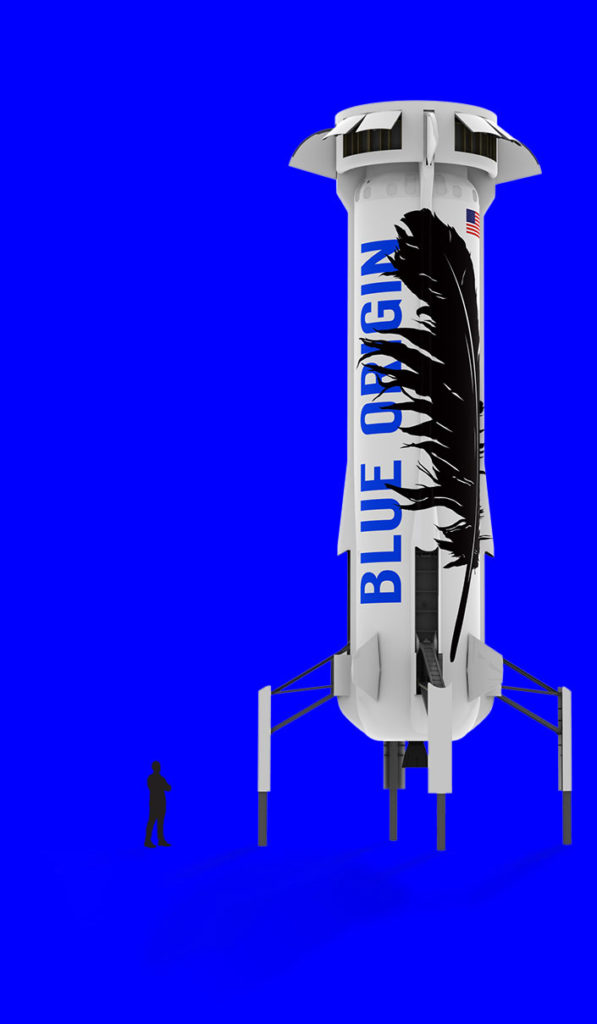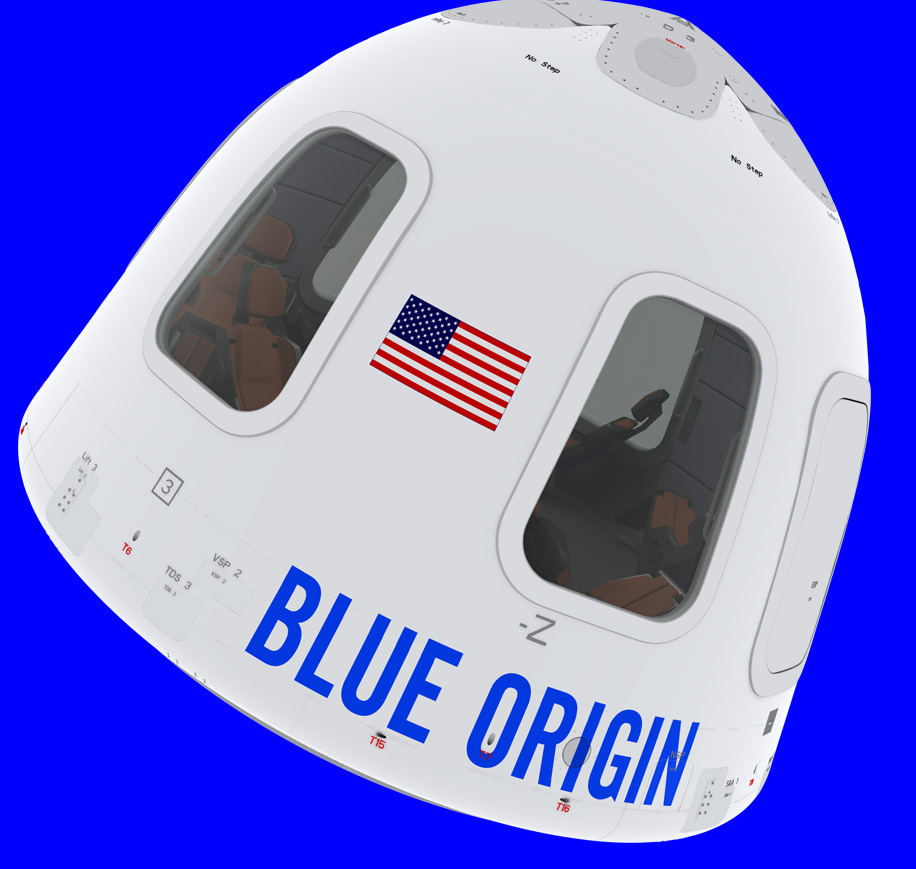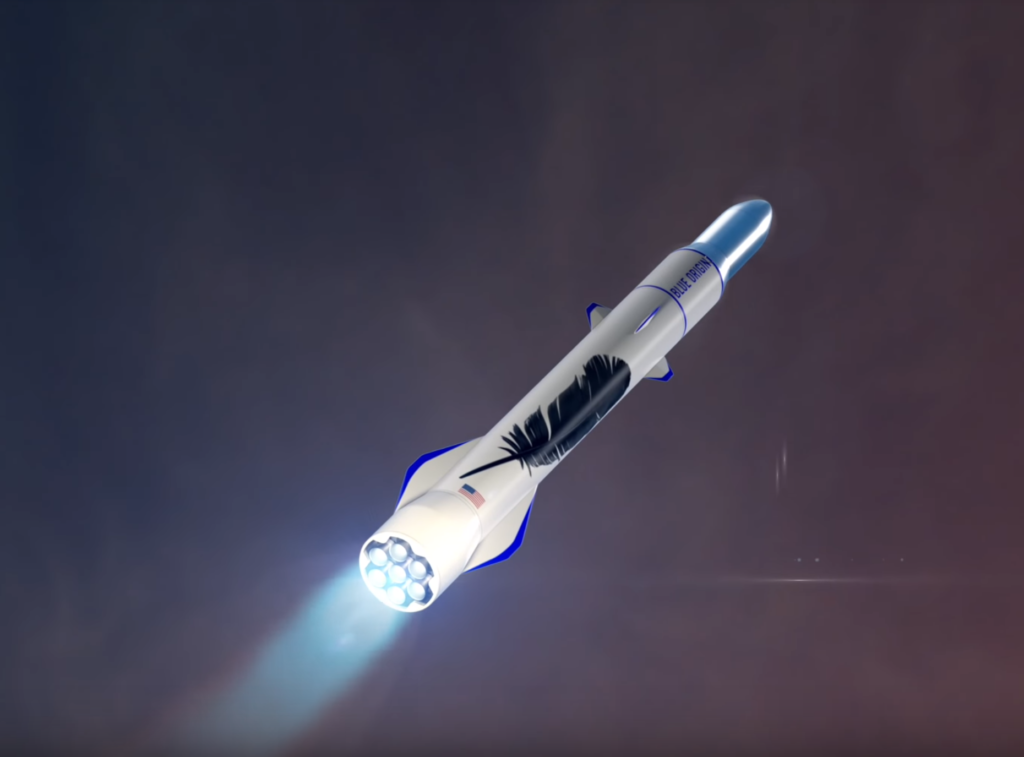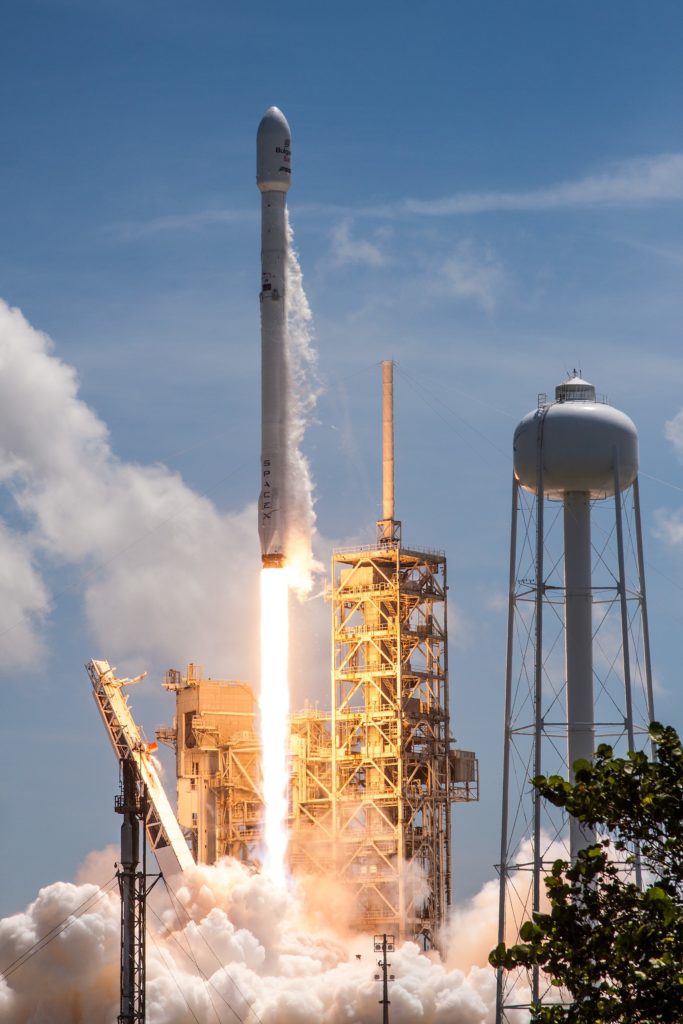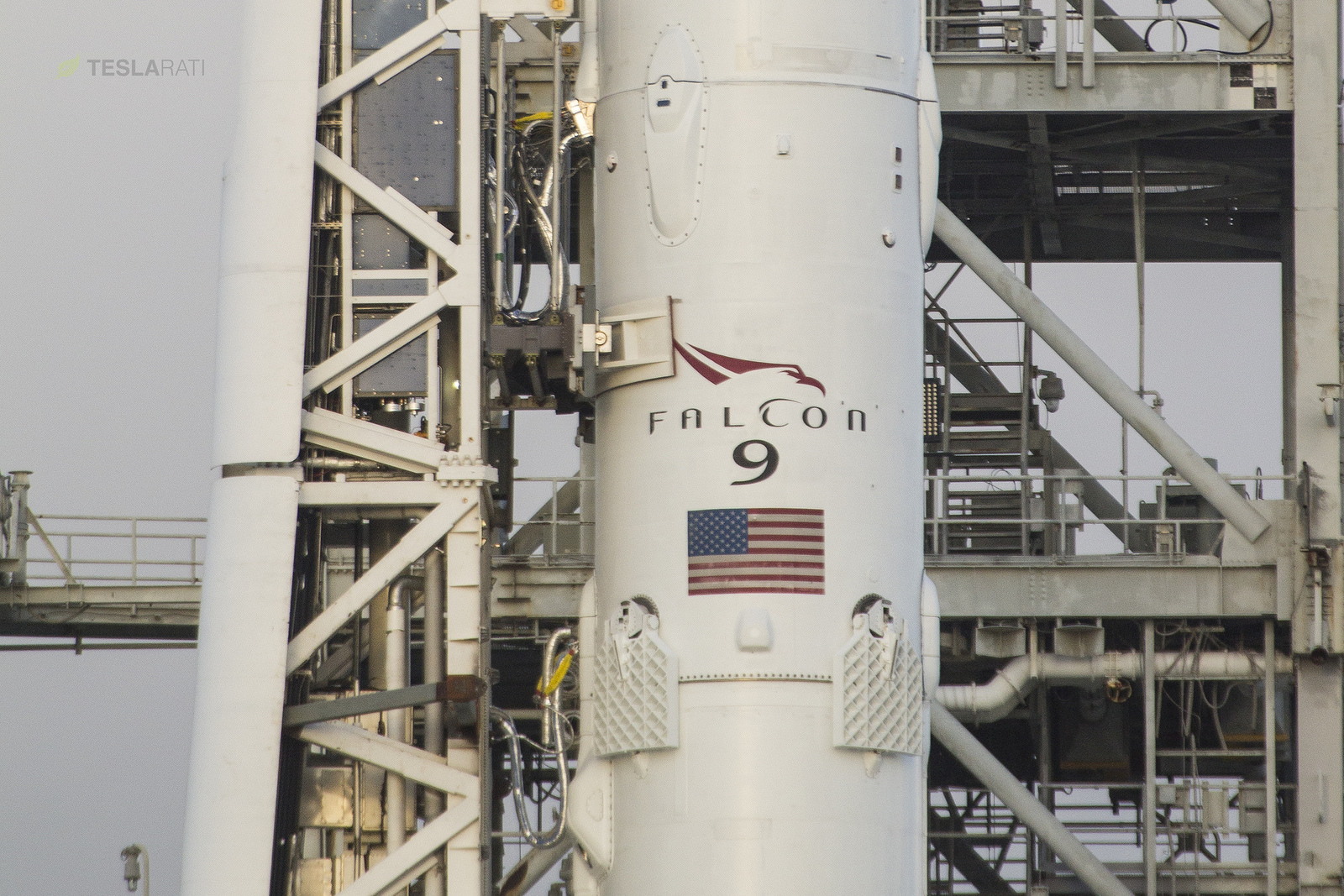
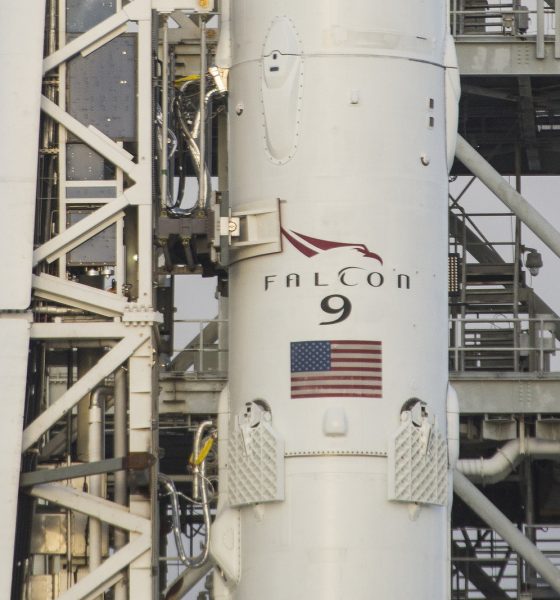
News
SpaceX vs. Blue Origin: The bickering titans of new space
In the past three years, SpaceX has made incredible progress in their program of reusability. In the practice’s first year, the young space company led by serial tech entrepreneur Elon Musk has performed three successful commercial reuses of Falcon 9 boosters in approximately eight months, and has at least two more reused flights scheduled before 2017 is out. Blue Origin, headed and funded by Jeff Bezos of Amazon fame, is perhaps most famous for its supreme confidence, best illustrated by Bezos offhandedly welcoming SpaceX “to the club” after the company first recovered the booster stage of its Falcon 9 rocket in 2015.
Blue Origin began in the early 2000s as a pet project of Bezos, a long-time fan of spaceflight and proponent of developing economies in space. After more than a decade of persistent development and increasingly complex testbeds, Blue Origin began a multi-year program of test flights with its small New Shepard launch vehicle. Designed to eventually launch tourists to the veritable edge of Earth’s atmosphere in a capsule atop it, New Shepard began its test flights in 2015 and after one partial failure, has completed five successful flights in a row. The space tourism company has subtly and not-so-subtly belittled SpaceX’s accomplishments over the last several years, and has engendered a fair bit of hostility towards it as a result.
Admittedly, CEO Elon Musk nurtured high expectations for the consequences of reuse, and has frequently discussed SpaceX’s ambition to reduce the cost of access to orbit by a factor of 10 to 100. However, after several reuses, it is clear that costs have decreased no more than 10-20%. What gives?
Well, Musk’s many comments on magnitudes of cost reduction were clearly premised upon rapid and complete reuse of both stages of Falcon 9, best evidenced by a concept video the company released in 2011.
The reality was considerably harder and Musk clearly underestimated the difficulty of second stage reuse, something he himself has admitted. COO Gwynne Shotwell was interviewed earlier this summer and discussed SpaceX’s updated approach to complete reusability, and acknowledged that second stage reuse was no longer a real priority, although the company will likely attempt second stage recovery as a validation of future technologies. Instead of pursuing the development of a completely reusable Falcon 9, SpaceX is instead pushing ahead with the development of a much larger rocket, BFR. BFR being designed to enable the sustainable colonization of space by realizing Musk’s original ambition of magnitudes-cheaper orbital launch capabilities.
Competition on the horizon?
Meanwhile, SpaceX’s only near-term competitor interested in serious reuse has made gradual progress over the last several years, accelerating its pace of development more recently. Blue Origin’s second New Shepard vehicle, designed to serve the suborbital space tourism industry, conducted an impressive five successful launches and landings over the course of 2016 before being summarily retired. NS2’s antecedent suffered a failure while attempting its first landing and was destroyed in 2015, but Blue learned quickly from the issues of Shepard 1 and has already shipped New Shepard 3 to its suborbital launch facilities near Van Horn, Texas. While NS3 is aiming for an inaugural flight later this year, NS4 is under construction in Kent, Washington and could support Blue’s first crewed suborbital launches in 2018.
More significant waves were made with an announcement in 2016 that Blue was pursuing development of a partially reusable orbital-class launch vehicle, the massive New Glenn. On paper, New Glenn is quite a bit larger than even SpaceX’s Falcon 9, and appears to likely be more capable than the company’s “world’s most powerful rocket” while completely recovering its boost stage. In a completed, manufactured, and demonstrably reliable form, New Glenn would be an extraordinarily impressive and capable launch vehicle that could undoubtedly catapult Blue Origin into position of true competition with SpaceX’s reusability efforts.
- The New Shepard booster. (Blue Origin)
- Blue Origin’s New Shepard capsule could carry passengers as high as 100km in 2018. (Blue Origin)
- A render of Blue Origin’s larger New Glenn vehicle. (Blue Origin)
However, while Blue Origin executives brag about “operational reusability” and tastelessly lampoon efforts that “decided to slap some legs on [to] see if [they] could land it”, the unmentioned company implicated in those barbs has begun to routintely and commercially reuse orbital-class boosters five times the size of Blue’s suborbital testbed, New Shepard.
Apples to oranges
The only point at which Blue Origin poses a risk to SpaceX’s business can be found in a comparison of funding sources. SpaceX first successes (and failures) were funded out of Elon Musk’s own pocket, but nearly all of the funding that followed was won through competitive government contracts and rounds of private investment. To put it more simply, SpaceX is a business that must balance costs and returns, while Blue Origin is funded exclusively out of billionaire CEO Jeff Bezos’ pocket.
As a result of being completely privately funded, Bezos’ deep pockets could render Blue more flexible than SpaceX when pricing launches. If Blue chooses to aggressively price New Glenn by accounting for booster reusability, it could pose a threat to SpaceX’s own business strategy. If SpaceX is unable to recoup its investment in reusability before New Glenn is regularly conducting multiple commercial missions per year, likely no earlier than 2021 or 2022, SpaceX’s Falcon 9 pricing could be rendered distinctly noncompetitive.
However, this concern seems almost entirely misplaced. SpaceX has half a decade of experience mass-producing orbital-class (reusable) rockets, (reusable) fairings, and propulsion systems, whereas Blue Origin at best has minimal experience manufacturing a handful of suborbital vehicles over a period of a few years. Blue has a respectable amount of experience with their BE-3 hydrolox propulsion system, and that will likely transfer over to the BE-3U vacuum variant to be used for New Glenn’s third stage. The large methalox rocket engine (BE-4) that will power New Glenn’s first stage also conducted its first-ever hot-fire just weeks ago, a major milestone in propulsion development but also a reminder that BE-4 has an exhaustive regime of engineering verification and flight qualification testing ahead of it.
First hotfire of our BE-4 engine is a success #GradatimFerociter pic.twitter.com/xuotdzfDjF
— Blue Origin (@blueorigin) October 19, 2017
Perhaps more importantly, the company’s relative success with New Shepard’s launch, recovery, and reuse has not and cannot move beyond small suborbital hops, and thus cannot provide the experience at the level of orbital rocketry. New Shepard is admittedly capable of reaching an altitude of 100km, but the suborbital vehicle’s flight regime does not require it to travel beyond Mach 4 (~1300 m/s). The first stage of Falcon 9, however, is approximately four times as tall and three times the mass of New Shepard, and boosters attempting recovery during geostationary missions routinely reach almost twice the velocity of New Shepard, entering the thicker atmosphere at more than 2300 m/s (1500-1800 m/s for LEO missions). Falcon 9’s larger mass and velocity translates into intense reentry heating and aerodynamic forces, best demonstrated by the glowing aluminum grid fins that can often be seen in SpaceX’s live coverage of booster recovery. Blue Origin’s New Glenn concept is extremely impressive on paper, but the company will have to pull off an extraordinary leap of technological maturation to move directly from suborbital single-stage hops to multi-stage orbital rocketry. Blue’s accomplishments with New Shepard are nothing to scoff at, but they are a far cry from routine orbital launch services.
SpaceX’s future fast approaches
Translating back to the new establishment, Falcon 9 will likely remain SpaceX’s workhorse rocket for some five or more years, at least until BFR can prove itself to be a reliable and affordable replacement. This change in focus, combined with the downsides of second stage recovery and reuse on a Falcon 9-sized vehicle, means that SpaceX will ‘only’ end up operationally reusing first stages and fairings from the vehicle. The second stage accounts for approximately 20-30% of Falcon 9’s total cost, suggesting that rapid and complete reuse of the fairing and first stage could more than halve its ~$62 million price. Yet this too ignores another mundane fact of corporate life SpaceX must face. Its executives, Musk included, have lately expressed a desire to at least partially recoup the ~$1 billion that was invested to develop reuse. Assuming a partial 10% reduction in cost to reuse customers and profit margins of 50% with rapid and total reuse of the first stage and fairing, 20 to 30 commercial reuses would recoup most or all of SpaceX’s reusability investment.
Musk recently revealed that SpaceX is aiming to complete 30 launches in 2018, and that figure will likely continue to grow in 2019, assuming no major anomalies occur. Manufacturing will rapidly become the main choke point for increased launch cadence, suggesting that drastically higher cadences will largely depend upon first stage reuse with minimal refurbishment, which just so happens to be the goal of the Falcon 9’s upcoming Block 5 iteration. Even if the modifications only manage a handful of launches without refurbishment, rather than the ten flights being pursued, each additional flight without maintenance will effectively multiply SpaceX’s manufacturing capabilities. More bluntly: ten Falcon 9s capable of five reflights could do the same job of 50 brand new rockets with 1/5th of the manufacturing backend.
- BulgariaSat-1 was successfully launched 48 hours before Iridium-2, and marked the second or three successful, commercial reuses of an orbital rocket. (SpaceX)
- SpaceX’s Hawthorne factory routinely churns out one to two complete Falcon 9s every month. (SpaceX)
- Falcon 9 B1040 returns to LZ-1 after the launch of the USAF’s X-37B spaceplane. (SpaceX)
Assuming that upcoming reuses proceed without significant failures and Falcon 9 Block 5 subsumes all manufacturing sometime in 2018 or 2019, it is entirely possible that SpaceX will undergo an extraordinarily rapid phase change from expendability to reusability. Mirroring 2017, we can imagine that SpaceX’s Hawthorne factory will continue to churn out at least 10 to 20 Block 5 Falcon 9s over the course of 2018. Assuming 5 to 10 maintenance-free reuses and a lifespan of as many as 100 flights with intermittent refurb, a single year of manufacturing could provide SpaceX with enough first stages to launch anywhere from 50 to 2000 missions. The reality will inevitably find itself somewhere between those extremely pessimistic and optimistic bookends, and they of course do not account for fairings, second stages, or expendable flights.
If we assume that the proportional cost of Falcon 9’s many components very roughly approximates the amount of manufacturing backend needed to produce them, downsizing Falcon 9 booster production by a factor of two or more could free a huge fraction of SpaceX’s workforce and floor space to be repurposed for fairing and second stage production, as well as the company’s Mars efforts. Such a phase change would also free up a considerable fraction of the capital SpaceX continually invests in its manufacturing infrastructure and workforce, capital that could then be used to ready SpaceX’s facilities for production and testing of its Mars-focused BFR and BFS.
“Gradatim ferociter”
It cannot be overstated that the speculation in this article is speculation. Nevertheless, it is speculation built on real information provided over the years by SpaceX’s own executives. Rough estimates like this offer a glimpse into a new launch industry paradigm that could be only a year or two away and could allow SpaceX to begin aggressively pursuing its goal of enabling a sustainable human presence on Mars and throughout the Solar System.
Blue Origin’s future endeavors shine on paper and their goal of enabling millions to work and live space are admirable, but the years between the present and a future of routine orbital missions for the company may not be kind. The engineering hurdles that litter the path to orbital rocketry are unforgiving and can only be exacerbated by blind overconfidence, a lesson that is often only learned the hard way. Blue Origin’s proud motto “Gradatim ferociter” roughly translates to “Step by step, ferociously.” One can only hope that some level of humility and sobriety might temper that ferocity before customers entrust New Glenn with their infrastructural foundations and passengers entrust New Shepard with their lives.

Cybertruck
Tesla updates Cybertruck owners on timeline of massive feature yet to ship

Tesla is updating Cybertruck owners on its timeline of a massive feature that has yet to ship: Powershare with Powerwall.
Powershare is a bidirectional charging feature exclusive to Cybertruck, which allows the vehicle’s battery to act as a portable power source for homes, appliances, tools, other EVs, and more. It was announced in late 2023 as part of Tesla’s push into vehicle-to-everything energy sharing, and acting as a giant portable charger is the main advantage, as it can provide backup power during outages.
Cybertruck’s Powershare system supports both vehicle-to-load (V2L) and vehicle-to-home (V2H), making it flexible and well-rounded for a variety of applications.
However, even though the feature was promised with Cybertruck, it has yet to be shipped to vehicles. Tesla communicated with owners through email recently regarding Powershare with Powerwall, which essentially has the pickup act as an extended battery.
Powerwall discharge would be prioritized before tapping into the truck’s larger pack.
However, Tesla is still working on getting the feature out to owners, an email said:
“We’re writing to let you know that the Powershare with Powerwall feature is still in development and is now scheduled for release in mid-2026.
This new release date gives us additional time to design and test this feature, ensuring its ability to communicate and optimize energy sharing between your vehicle and many configurations and generations of Powerwall. We are also using this time to develop additional Powershare features that will help us continue to accelerate the world’s transition to sustainable energy.”
Owners have expressed some real disappointment in Tesla’s continuous delays in releasing the feature, as it was expected to be released by late 2024, but now has been pushed back several times to mid-2026, according to the email.
Foundation Series Cybertruck buyers paid extra, expecting the feature to be rolled out with their vehicle upon pickup.
Cybertruck’s Lead Engineer, Wes Morrill, even commented on the holdup:
As a Cybertruck owner who also has Powerwall, I empathize with the disappointed comments.
To their credit, the team has delivered powershare functionality to Cybertruck customers who otherwise have no backup with development of the powershare gateway. As well as those with solar…
— Wes (@wmorrill3) December 12, 2025
He said that “it turned out to be much harder than anticipated to make powershare work seamlessly with existing Powerwalls through existing wall connectors. Two grid-forming devices need to negotiate who will form and who will follow, depending on the state of charge of each, and they need to do this without a network and through multiple generations of hardware, and test and validate this process through rigorous certifications to ensure grid safety.”
It’s nice to see the transparency, but it is justified for some Cybertruck owners to feel like they’ve been bait-and-switched.
News
Tesla’s northernmost Supercharger in North America opens

Tesla has opened its northernmost Supercharger in Fairbanks, Alaska, with eight V4 stalls located in one of the most frigid cities in the U.S.
Located just 196 miles from the Arctic Circle, Fairbanks’s average temperature for the week was around -12 degrees Fahrenheit. However, there are plenty of Tesla owners in Alaska who have been waiting for more charging options out in public.
There are only 36 total Supercharger stalls in Alaska, despite being the largest state in the U.S.
Eight Superchargers were added to Fairbanks, which will eventually be a 48-stall station. Tesla announced its activation today:
North America’s northernmost Supercharger Fairbanks, AK (8 stalls) opened to public. https://t.co/M4l04DZ6B5 pic.twitter.com/zyL6bDuA93
— Tesla Charging (@TeslaCharging) December 12, 2025
The base price per kWh is $0.43 at the Fairbanks Supercharger. Thanks to its V4 capabilities, it can charge at speeds up to 325 kW.
Despite being the northernmost Supercharger in North America, it is not even in the Top 5 northernmost Superchargers globally, because Alaska is south of Norway. The northernmost Supercharger is in Honningsvåg, Norway. All of the Top 5 are in the Scandanavian country.
Tesla’s Supercharger expansion in 2025 has been impressive, and although it experienced some early-quarter slowdowns due to V3-to-V4 hardware transitions, it has been the company’s strongest year for deployments.
🚨🚨 Tesla Supercharging had a HUGE year, and they deserve to be recognized.
🍔 Opened Tesla Diner, a drive-in movie theater with awesome, Chef-curated cuisine
🔌 Gave access to Superchargers to several EV makers, including Hyundai, Genesis, Mercedes-Benz, Kia, Lucid, Toyota,… pic.twitter.com/yYT2QEbqoW
— TESLARATI (@Teslarati) December 10, 2025
Through the three quarters of 2025, the company has added 7,753 stations and 73,817 stalls across the world, a 16 percent increase in stations and an 18 percent increase in stalls compared to last year.
Tesla is on track to add over 12,000 stalls for the full year, achieving an average of one new stall every hour, an impressive statistic.
Recently, the company wrapped up construction at its Supercharger Oasis in Lost Hills, California, a 168-stall Supercharger that Tesla Solar Panels completely power. It is the largest Supercharger in the world.
News
Tesla shocks with latest Robotaxi testing move
Why Tesla has chosen to use a couple of Model S units must have a reason; the company is calculated in its engineering and data collection efforts, so this is definitely more than “we just felt like giving our drivers a change of scenery.”

Tesla Model S vehicles were spotted performing validation testing with LiDAR rigs in California today, a pretty big switch-up compared to what we are used to seeing on the roads.
Tesla utilizes the Model Y crossover for its Robotaxi fleet. It is adequately sized, the most popular vehicle in its lineup, and is suitable for a wide variety of applications. It provides enough luxury for a single rider, but enough room for several passengers, if needed.
However, the testing has seemingly expanded to one of Tesla’s premium flagship offerings, as the Model S was spotted with the validation equipment that is seen entirely with Model Y vehicles. We have written several articles on Robotaxi testing mules being spotted across the United States, but this is a first:
🚨 Tesla is using Model S vehicles fitted with LiDAR rigs to validate FSD and Robotaxi, differing from the Model Ys that it uses typically
Those Model Y vehicles have been on the East Coast for some time. These Model S cars were spotted in California https://t.co/CN9Bw5Wma8 pic.twitter.com/UE55hx5mdd
— TESLARATI (@Teslarati) December 11, 2025
Why Tesla has chosen to use a couple of Model S units must have a reason; the company is calculated in its engineering and data collection efforts, so this is definitely more than “we just felt like giving our drivers a change of scenery.”
It seems to hint that Tesla could add a premium, more luxury offering to its Robotaxi platform eventually. Think about it: Uber has Uber Black, Lyft has Lyft Black. These vehicles and services are associated with a more premium cost as they combine luxury models with more catered transportation options.
Tesla could be testing the waters here, and it could be thinking of adding the Model S to its fleet of ride-hailing vehicles.
Reluctant to remove the Model S from its production plans completely despite its low volume contributions to the overall mission of transitioning the world to sustainable energy, the flagship sedan has always meant something. CEO Elon Musk referred to it, along with its sibling Model X, as continuing on production lines due to “sentimental reasons.”
However, its purpose might have been expanded to justify keeping it around, and why not? It is a cozy, premium offering, and it would be great for those who want a little more luxury and are willing to pay a few extra dollars.
Of course, none of this is even close to confirmed. However, it is reasonable to speculate that the Model S could be a potential addition to the Robotaxi fleet. It’s capable of all the same things the Model Y is, but with more luxuriousness, and it could be the perfect addition to the futuristic fleet.
